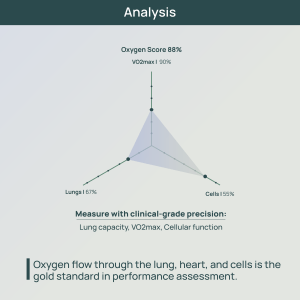What fuel source are you using in your workout?
 FUEL SOURCES BY ZONE AND TRAINING TYPE
FUEL SOURCES BY ZONE AND TRAINING TYPE
- Free Fatty Acid – ZI – Recovery
- Aerobic Glycolysis – Z2 – LSD/Cardio
- Anaerobic Glycolysis – Z3 – Tempo/Long Intervals
- Lactate/Phosphorylation – Z4 – Medium Intervals
- ATP-PC/CrP – Z5 – Short Intervals
The breakdown of fuel sources by zone and training type refers to the utilization of different energy systems during various intensity levels of exercise. Different zones correspond to specific heart rate or intensity ranges, and each zone primarily relies on specific fuel sources.
Here’s an explanation of the fuel sources and their associated training zones:
- Free Fatty Acid (FFA) – Zone 1 (Recovery):
- Fuel Source: Free fatty acids are derived from stored fats.
- Training Type: Zone 1 corresponds to low-intensity activities, such as recovery workouts. During these periods, the body primarily relies on the aerobic metabolism of fats for energy.
- Aerobic Glycolysis – Zone 2 (LSD/Cardio):
- Fuel Source: Carbohydrates, specifically glucose, are the main fuel source through aerobic glycolysis.
- Training Type: Zone 2 is associated with Long Slow Distance (LSD) or steady-state cardio workouts. This intensity level allows the body to efficiently utilize oxygen to metabolize carbohydrates for sustained energy.
- Anaerobic Glycolysis – Zone 3 (Tempo/Long Intervals):
- Fuel Source: Carbohydrates, with an emphasis on anaerobic glycolysis leading to lactate production.
- Training Type: Zone 3 involves tempo or long intervals and is characterized by increased intensity. The body relies more on anaerobic glycolysis to produce energy, leading to lactate accumulation.
- Lactate/Phosphorylation – Zone 4 (Medium Intervals):
- Fuel Source: Lactate, ATP, and phosphocreatine (CrP) contribute to energy production.
- Training Type: Zone 4 corresponds to medium intervals, where the emphasis is on sustained efforts at a higher intensity. The body relies on lactate metabolism and phosphorylation for energy.
- ATP-PC/CrP – Zone 5 (Short Intervals):
- Fuel Source: Phosphocreatine (CrP) and ATP are rapidly mobilized for quick bursts of energy.
- Training Type: Zone 5 involves short intervals with high-intensity efforts. The body primarily utilizes the ATP-PC (adenosine triphosphate-phosphocreatine) system for immediate energy needs.
In summary, the fuel sources and associated training types in different zones reflect the body’s metabolic adaptations to varying exercise intensities. Lower-intensity zones rely more on aerobic metabolism and fat oxidation, while higher-intensity zones involve a shift toward anaerobic glycolysis and other rapid energy systems. Training across these zones helps optimize overall fitness and performance.
During Zone 1 and Zone 2 exercises, the body primarily relies on the breakdown of free fatty acids (FFAs) for fuel. This process is part of aerobic metabolism, where oxygen is available to facilitate the breakdown of fats.
Here’s an overview of how FFAs are broken down for fuel during Zone 1 and Zone 2 exercises:
Zone 1 Exercise (Recovery):
- Low Intensity:
- Zone 1 corresponds to low-intensity exercise, such as recovery workouts.
- The intensity is mild enough that the body can meet its energy demands through aerobic metabolism.
- Oxygen Availability:
- Adequate oxygen is available during Zone 1 exercise, allowing for the efficient utilization of aerobic pathways.
- Fat Mobilization:
- In Zone 1, the body primarily relies on stored fats. Adipose tissue releases triglycerides, which are broken down into glycerol and FFAs.
- Beta-Oxidation:
- FFAs undergo a process called beta-oxidation within the mitochondria.
- This process breaks down FFAs into acetyl-CoA, which enters the Krebs cycle, a part of aerobic metabolism.
- Energy Production:
- The acetyl-CoA generated from FFAs is further processed in the Krebs cycle to produce reducing equivalents (NADH and FADH2).
- These reducing equivalents are then used in the electron transport chain to produce ATP through oxidative phosphorylation.
Zone 2 Exercise (LSD/Cardio):
- Moderate Intensity:
- Zone 2 corresponds to moderate-intensity exercise, such as Long Slow Distance (LSD) or steady-state cardio workouts.
- Aerobic Metabolism:
- Zone 2 exercise still relies on aerobic metabolism, and oxygen is readily available to support this process.
- Fat Utilization:
- The primary fuel source in Zone 2 is free fatty acids, similar to Zone 1. However, the intensity is higher, and the body may start to shift toward greater reliance on carbohydrates.
- Optimal Fat Oxidation:
- Zone 2 is often considered an optimal intensity for fat oxidation. The body efficiently uses both fats and carbohydrates for energy, and the balance depends on factors like fitness level and training history.
- Endurance Training Adaptations:
- Regular training in Zone 2 can lead to endurance adaptations, such as increased mitochondrial density and improved fat oxidation, enhancing the body’s ability to utilize FFAs for sustained energy.
In both Zone 1 and Zone 2 exercises, the breakdown of free fatty acids for fuel is a gradual process that supports prolonged, low-to-moderate intensity activities.
The key is the availability of oxygen, which enables the efficient metabolism of fats through beta-oxidation and subsequent energy production in the mitochondria.
What is AEROBIC Glycolysis vs. Anaerobic Glycolys is?
is?
Aerobic glycolysis and anaerobic glycolysis are two phases of the metabolic process known as glycolysis, which is the initial step in the breakdown of glucose to produce energy.
These processes differ in their dependence on the availability of oxygen.
- Aerobic Glycolysis:
- Definition: Aerobic glycolysis refers to the process of glycolysis that occurs in the presence of oxygen.
- Location: It takes place in the cytoplasm of the cell.
- Outcome: In aerobic conditions, the end product of glycolysis is pyruvate.
- Energy Yield: Aerobic glycolysis is more efficient t in terms of energy production compared to anaerobic glycolysis.
- The pyruvate produced can enter the mitochondria and participate in the Krebs cycle and oxidative phosphorylation, yielding a higher number of ATP molecules.
- Anaerobic Glycolysis:
- Definition: Anaerobic glycolysis is the process of glycolysis that occurs in the absence of oxygen.
- Location: It also occurs in the cytoplasm of the cell.
- Outcome: In anaerobic conditions, the end product of glycolysis is lactate (or lactic acid in some contexts), not pyruvate.
- Energy Yield: Anaerobic glycolysis is less efficient in terms of energy production compared to aerobic glycolysis.
- It produces a smaller amount of ATP per glucose molecule because the process stops at the production of lactate without utilizing the mitochondria for further energy extraction.
In summary, the key difference between aerobic and anaerobic glycolysis lies in the final fate of pyruvate and the efficiency of ATP production. In the presence of oxygen (aerobic conditions), pyruvate enters the mitochondria for further energy extraction, while in the absence of oxygen (anaerobic conditions), pyruvate is converted to lactate, resulting in less efficient ATP production.




 FUEL SOURCES BY ZONE AND TRAINING TYPE
FUEL SOURCES BY ZONE AND TRAINING TYPE
 is?
is?